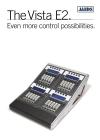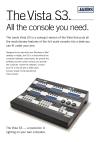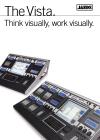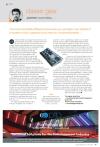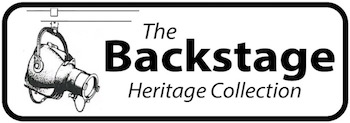
Vista (2004)
Jands

Jands Vista T4
Previewed at PLASA 2003
Available for sale in August 2004
From 2005 website:
Imagine ...
Imagine if you could design your lightshow the way you see it—visually.
Imagine if you didn't have to convert your mind's eye into a complex series of numbers, then spend ages punching them in. Imagine if you could create lighting effects the way you'd create a painting—with broad brush strokes.
Well finally someone has built a console with you, the lighting designer and operator, in mind. A console that releases your creativity by removing all the hassle and tedious hack work of programming, a console that is fast and easy to use.
That console is the Jands Vista, and it will completely change the way you create your lightshows. Once you've tried it, we reckon you'll never want to go back to the old number-crunching grind.
Timeline
Plan your action over a moving timeline
Computer-based audio and video editing tools have made the idea of a ‘timeline’ instantly familiar: displaying a piece of music or video as a ‘clip’ moving across the screen over time. The Vista applies this concept to lighting, and the result is an entirely new approach to design and performance.
See what’s really going on for the first time
With the Vista you can actually see everything that's happening in your design in relation to time: when lights come on, when they go off, when they change colour, when they move. Whatever the sequence of events, you can see it all laid out in front of you, and what’s more, you can change any of it simply by picking up the pen, selecting an event and moving it around.
Create complex effects in a fraction of the time
Let’s say you want to create a colour peel down: instead of translating this fundamentally visual concept into a sequence of 25 keystrokes then punching them into the keypad, with the Vista you just grab the pen and skew the colour information on the timeline. With a few broad strokes you can create the entire effect, without having to turn your brain into a computer to do it.
Find and fix problems quickly and easily
No more playing and re-playing entire sequences to find one small problem. With the Vista you simply find the exact spot you want on the timeline, then jump in and make your changes, quickly and easily, without punching a single button.
Pen tablet
Draw your show with the best drawing tool ever invented—the pen
We've thrown away the old methods of touch screens, tables of numbers and deeply-embedded menus, and replaced them with a window-based screen that is immediately familiar to anyone who's ever used a modern computer application.
Instead of a touch screen, the Vista uses a pen. This works in much the same way as a mouse, except that you use it to draw on the screen the same way you'd draw on a page. The combination of the pen with our simple, easy to use visual interface makes the Vista the first console that lets you build your lighting designs visually.
The Vista puts everything you need on the one screen. No more flicking through menus just to change a colour or a gobo—with the Vista you just point your pen at the colour palette and drag it around to choose the one you want. If you want more precision you can choose from a huge list of manufacturer’s gels, or set the exact CMY values you want—all of this on one screen and in just a few seconds.
Performance
Adapt to fixture changes - automatically
One of the most common hassles of using a conventional lighting console is having to adapt to changes in fixtures. On most other consoles if you change a fixture type you have to re-program the whole instruction set to match the configuration of the replacement light, a job that can take hours.
Not on the Vista though: this console records the actual colours, beams and other key details, so when you change a light, the console compares the abilities of the lights and works out how to adapt to it—even if the new light doesn't have the same feature set. Your show doesn't change, and you don't have to lift a finger.
What about live performance though?
Ask a lighting operator what they want for a live performance, and you're bound to hear "More faders and user-definable buttons". With the Vista, we've taken this wisdom on board and created the ultimate live performance desk.
With the Vista you can split the fader banks to double your playbacks or combine them to give you dedicated control of timing, chase speed and more. You can even use the encoder wheels to set timing and chase speed, and to move through the timelines of your clips. No more switching from page to page or running out of faders with this console.
Vista T2 / Vista T4 (2004)
Vista S3 (2005)
Introducing the Vista S3 - a revolution in lighting on your computer
The Jands Vista S3 is a compact version of the Vista that puts all the revolutionary features of the full-scale console into a desk you can fit under your arm. Designed to be used with your Windows or Mac* desktop or laptop, the S3 is a Vista without the computer hardware components: we provide the software and the control surface, you provide the computer. Install the software, connect your PC to the S3 with a USB cable, and you've got a fully-operational Vista console.
Vista E2 Console Extender (2005)
Introducing the Vista E2 - Even more control possibilities
Connecting, via USB, to a Vista T2 or T4, the E2 extends your console, providing either another two playback panels or one playback and one programming panel along with four additional DMX outputs.
Vista T2/T4 Specifications
Hardware
High performance 2.8GHz/533MHZ Pentium4 TM CPU
Memory: 512 Mbytes (Expandable to 1.0 Gbyte)
40GB Hard drive
Integrated CD/RW drive for show storage and backup (CD-RW: 52/24/52X) drive
Shock absorbent hard drive and tablet mountings
QWERTY 88 button keyboard
Trackpad — supplementary pointing device
Inputs & Outputs
Supports Eight (8) Universes
Four (4) DMX outputs: AXR 5-pin female socket, 3 wire DMX-512/1990 / RDM compatible
Ethernet: One (1) x 10/1000BaseT RJ45 — compatible with ART-NET and Pathport
USB: Three (3) x Type A USB2.0
Linear Time code input: One (1) x 3 pin AXR female socket, 0.5Vpp, 1.2Vpp max. Frame rates 1/20th to 60x normal accepted
MIDI in/thru/out: Three (3) x 5-pin 180° DIN socket RS232
COM port: One (1) x DB9 socket
External Monitor Outputs: Two (2) x high density DB15 socket, 1024x768 pixels per monitor
Desk lamp out: Two (2) x AXR 3-pin female socket, 12V current limited (dimmable, 10W total)
Audio mic/line in/line out: three (3) x 3.5mm jack socket
Trigger in/out: One (1) x 6.5mm jack socket 5Vpp
Power
Power Supply: Universal 100~264 VAC +/-10%, 47~63 Hz, 10A max
Power Consumption: 400W max
Inrush Current: 120A @ 230VAC 25C cold start
Power Factor: >85% typical @ 115VAC
Mains Connector: One (1) x IEC 3-pin socket
Dimensions
Dimensions T4: 1284mm(W) x 638mm(D) x 218mm(H)
Dimensions T2: 864mm(W) x 638mm(D) x 218mm(H)
Net/shipping weight: 45/77kg
See also:
Documents
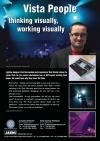
Advert: Jands Vista (September 2005)
Click on thumbnail to enlarge
[200kb JPEG]
From Lighting & Sound International
Back to Control - Memory (Jands)
270


